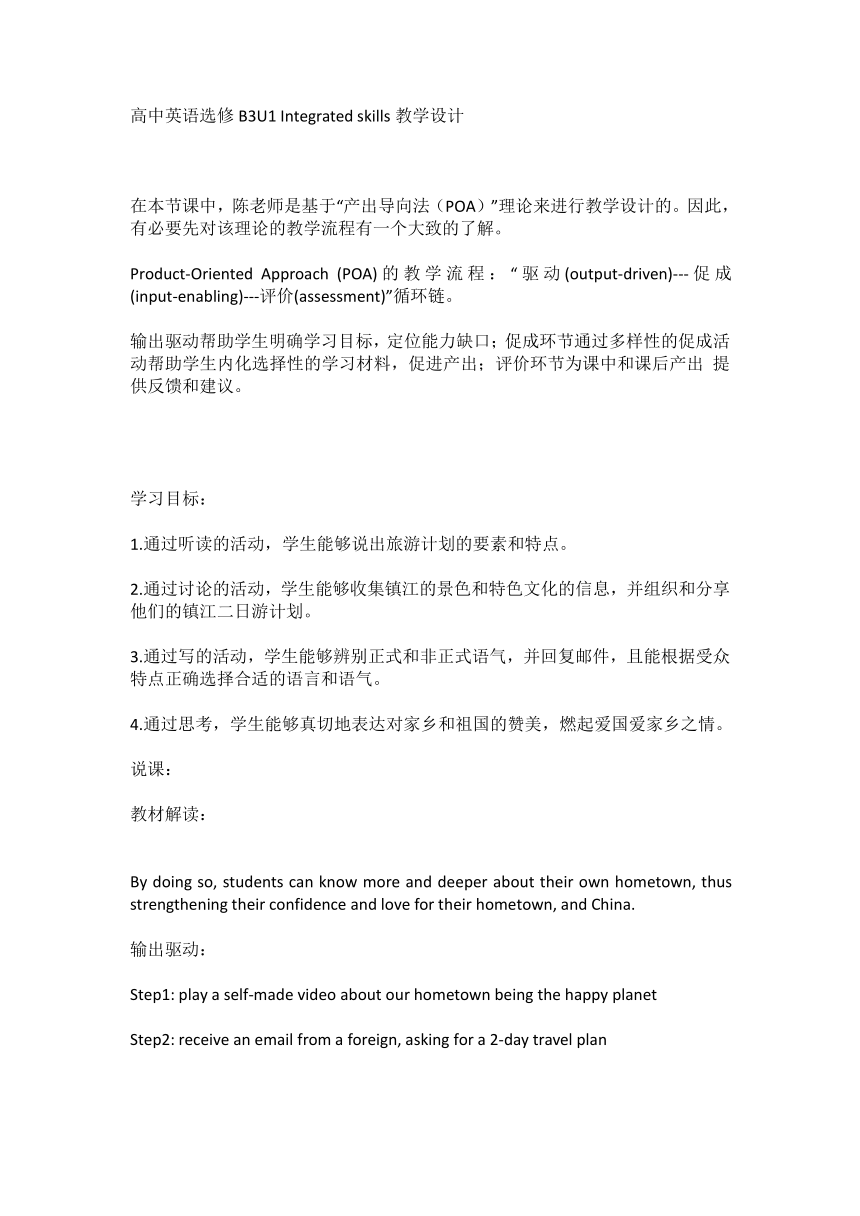牛津译林版(2019)必修 第三册Unit 1 Nature in the balance Integrated skills教学设计
文档属性
| 名称 | 牛津译林版(2019)必修 第三册Unit 1 Nature in the balance Integrated skills教学设计 |  | |
| 格式 | docx | ||
| 文件大小 | 15.7KB | ||
| 资源类型 | 教案 | ||
| 版本资源 | 牛津译林版(2019) | ||
| 科目 | 英语 | ||
| 更新时间 | 2024-02-27 21:52:42 | ||
图片预览

文档简介
高中英语选修B3U1 Integrated skills教学设计
在本节课中,陈老师是基于“产出导向法(POA)”理论来进行教学设计的。因此,有必要先对该理论的教学流程有一个大致的了解。
Product-Oriented Approach (POA)的教学流程:“驱动(output-driven)---促成(input-enabling)---评价(assessment)”循环链。
输出驱动帮助学生明确学习目标,定位能力缺口;促成环节通过多样性的促成活动帮助学生内化选择性的学习材料,促进产出;评价环节为课中和课后产出 提供反馈和建议。
学习目标:
1.通过听读的活动,学生能够说出旅游计划的要素和特点。
2.通过讨论的活动,学生能够收集镇江的景色和特色文化的信息,并组织和分享他们的镇江二日游计划。
3.通过写的活动,学生能够辨别正式和非正式语气,并回复邮件,且能根据受众特点正确选择合适的语言和语气。
4.通过思考,学生能够真切地表达对家乡和祖国的赞美,燃起爱国爱家乡之情。
说课:
教材解读:
By doing so, students can know more and deeper about their own hometown, thus strengthening their confidence and love for their hometown, and China.
输出驱动:
Step1: play a self-made video about our hometown being the happy planet
Step2: receive an email from a foreign, asking for a 2-day travel plan
老师好搞笑哈哈多才多艺
输入促成:
Step3: make a 2-day travel plan
call Steven for more information (listening)
study the sample travel plan about Shanghai (reading)
discuss the 2-day travel plan in pairs (speaking)
Step4: write the travel plan in email
以评促学:
Step5: assess the email by peers and teachers
评价结束后的课堂案例:
Step6: email the letter to Michael and ask students: how would Michael feel
发送邮件to Michael. So just imagine, if you were Michael, when you receive such a letter, how would you feel
Step7: receive a reply email from Michael and ask students: how do you feel
After receiving Michael's letter, how would you feel
在本节课中,陈老师是基于“产出导向法(POA)”理论来进行教学设计的。因此,有必要先对该理论的教学流程有一个大致的了解。
Product-Oriented Approach (POA)的教学流程:“驱动(output-driven)---促成(input-enabling)---评价(assessment)”循环链。
输出驱动帮助学生明确学习目标,定位能力缺口;促成环节通过多样性的促成活动帮助学生内化选择性的学习材料,促进产出;评价环节为课中和课后产出 提供反馈和建议。
学习目标:
1.通过听读的活动,学生能够说出旅游计划的要素和特点。
2.通过讨论的活动,学生能够收集镇江的景色和特色文化的信息,并组织和分享他们的镇江二日游计划。
3.通过写的活动,学生能够辨别正式和非正式语气,并回复邮件,且能根据受众特点正确选择合适的语言和语气。
4.通过思考,学生能够真切地表达对家乡和祖国的赞美,燃起爱国爱家乡之情。
说课:
教材解读:
By doing so, students can know more and deeper about their own hometown, thus strengthening their confidence and love for their hometown, and China.
输出驱动:
Step1: play a self-made video about our hometown being the happy planet
Step2: receive an email from a foreign, asking for a 2-day travel plan
老师好搞笑哈哈多才多艺
输入促成:
Step3: make a 2-day travel plan
call Steven for more information (listening)
study the sample travel plan about Shanghai (reading)
discuss the 2-day travel plan in pairs (speaking)
Step4: write the travel plan in email
以评促学:
Step5: assess the email by peers and teachers
评价结束后的课堂案例:
Step6: email the letter to Michael and ask students: how would Michael feel
发送邮件to Michael. So just imagine, if you were Michael, when you receive such a letter, how would you feel
Step7: receive a reply email from Michael and ask students: how do you feel
After receiving Michael's letter, how would you feel
同课章节目录
- Unit 1 Nature in the balance
- Welcome to the unit
- Reading
- Grammar and usage
- Integrated skills
- Extended reading
- Project
- Unit 2 Natural disasters
- Welcome to the unit
- Reading
- Grammar and usage
- Integrated skills
- Extended reading
- Project
- Unit 3 The world online
- Welcome to the unit
- Reading
- Grammar and usage
- Integrated skills
- Extended reading
- Project
- Unit 4 Scientists who changed the world
- Welcome to the unit
- Reading
- Grammar and usage
- Integrated skills
- Extended reading
- Project
